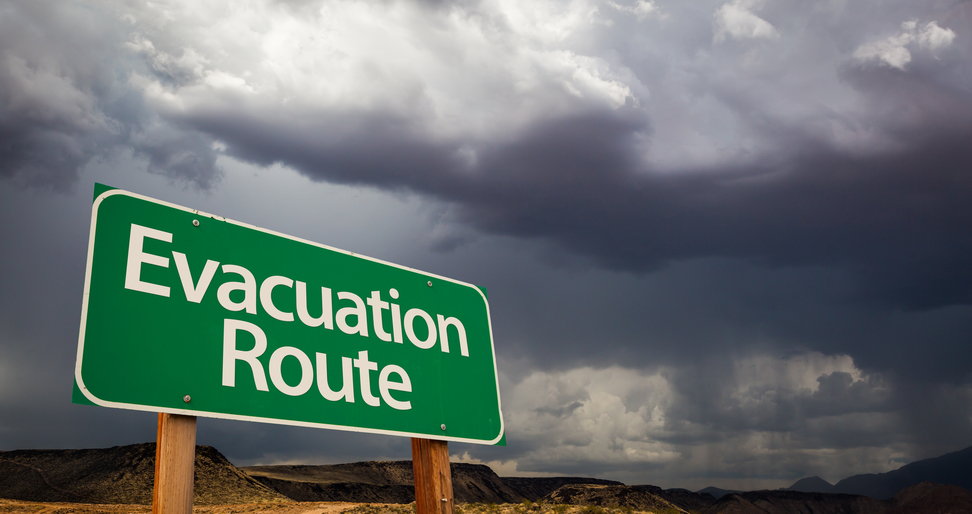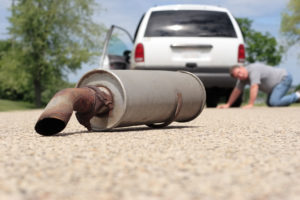
Evacuation Route Green Road Sign with Dramatic Clouds and Rain.
Evacuation Route Green Road Sign with Dramatic Clouds and Rain.
One tactic constantly being thrown around during survival, self-reliance and preparedness discussions is the concept of “bugging out.” Simply put, this is the idea when a large-scale emergency or social disruption occurs, you will grab your BOB (Bug Out Bag), jump into your official Bug Out Vehicle, call in the Bug Out Dogs and rush headlong to your official Bug Out Location somewhere in the hinterlands.
It’s a great plan — in theory — but have you stopped to think about the practicality of such romantic notions?
When to leave
 Getting the heck out of Dodge is a great idea in certain situations. For example, if you are squarely in the crosshairs of a major hurricane, a reasonable course of action is to leave the area for the duration and immediate aftermath. I wouldn’t fault you for staying home to protect your property but I’d rather be somewhere else mixing cocktails instead of standing guard over the barnacle-encrusted remains of my garage while dreaming of a cool drink and warm shower.
Getting the heck out of Dodge is a great idea in certain situations. For example, if you are squarely in the crosshairs of a major hurricane, a reasonable course of action is to leave the area for the duration and immediate aftermath. I wouldn’t fault you for staying home to protect your property but I’d rather be somewhere else mixing cocktails instead of standing guard over the barnacle-encrusted remains of my garage while dreaming of a cool drink and warm shower.
Massive civil unrest is another situation where leaving is a first-choice response. If I lived in New York City, Chicago, Detroit, Los Angeles or any large urban area (especially those in Democrat-controlled areas which, lately, have shown a serious disdain for the rule of law), I’d consider it imperative to flee the area immediately in the event of a major uprising.
Sadly, after the previous paragraph was written, things took a serious turn for the worse and your next step might be to call a moving van.
Perhaps you already have a well-prepared cabin tucked back in the hills a few hundred miles away. In such a case, it makes sense to evacuate to a more defendable, advantageous position when things get ugly. However, the majority of folks aren’t in such unique situations or have the luxury of owning a well-stocked survival retreat. Yet, many in the preparedness community still seem intent on leaving town after a catastrophe.
I often giggle when imaging a scenario where “survivors” pass each other while driving desperately to their chosen bug-out location, the southerners headed north and damn Yankees moving south. Then, once everyone arrives at their destination, there is no place to park.
At the same time, the folks who actually live in these rural areas won’t be exactly pleased to see hordes of newcomers arrive, especially during a national crisis. In the smallish town where I live, someone is still considered a carpetbagger if they’ve held residency for less than 25 years. Conflict would be immediate and ugly.
Living off the land?

Do you really know the difference between tasty and toxic for many types of wild food? Maybe living off the land is tougher than you imagine.
Those who are truly adventurous souls often plan to head into “The Wilderness.” There, once the metaphoric balloon goes up, it seems likely that the forest will be busier than Times Square when everyone plops down on their imagined slice of paradise. Things will quickly become untenable as hungry hordes eat all available animal protein and obvious vegetable food in sight. Once the limited supply of opossums and persimmons has been digested, food becomes scarce and very labor-intensive to gather, assuming you’ve done enough research to know the difference between tasty and toxic.
Speaking of research, have you actually made acorn flour, eaten boiled cattail roots or whatever else is appropriate for your intended destination? I have and, with apologies to Euell Gibbons, quickly discovered why they haven’t replaced cheeseburgers and fries on America’s dinner tables. Think about that before leaving a well-stocked pantry back home to ‘live off the land.’
Transport

Your car, truck, van, motorcyles, bicycle or yak never breaks down, runs out of fuel or crashes, right?!?
There are also transportation issues. If the situation has devolved into a region-wide or world-changing calamity, will roads even be available? Of course you’ve got a four-wheel-drive vehicle that can climb trees and ford rivers but unless you plan on heading to a location within three hundred miles or so, there probably won’t be any fuel available to get you there.
Of course, you already stockpile extra fuel but what about those collapsed or unsafe bridges, official or impromptu checkpoints and the occasional groups of rogues and bandits? Of course your vehicle will never suffer a mechanical breakdown, either.
Forced to abandon transportation, are you prepared to walk and carry all your supplies? This scenario assumes you have proper clothing for the weather along with ample food, water purification and means of self-defense. Of course there are further problems if someone in your group is ill, injured or otherwise unable to shoulder their share of the load.
As a veteran backpacker, I know that seeing America on foot is a great way to travel but doing so after some massive disaster or societal breakdown is not an optimal approach to transportation, especially when burdened with long-term supplies.
Conclusions
Obviously, there are serious practical and logistical concerns when bugging out so the whole idea begs the basic question: is the grass really greener on the other side of the fence (or nearest state line)?
The answer in most cases is an emphatic No.
This means after those routine end-of-the-world-as-we-know-it, feces-hit-the-whirling-air-movement-device situations, your primary plan should be to stay put unless there are overwhelming reasons to leave.
Consider, in my experience, most folks already have some basic level of resources and supplies in place for emergencies. Even if you are not a “prepper,” there are an untold number of things in your home to help you weather any storm. Your friends, neighbors and nearby family likewise have lots of similarly useful “stuff.”
So, unless you plan on loading up a couple of trucks full of your worldly possessions and a few busloads of worthwhile people, why would we leave shelter, weapons stockpiles, food, tools, personal possessions, career, extended family, friends, business associates and cooperative neighbors behind for an unknown life “in the woods” (or “down south,” “up north,” “out west,” “in the mountains,” ect.) Even if you prepare to make such a mass exodus, will things truly be better wherever you end up? In most cases, I sincerely doubt it.
It has been said that when the going gets tough, the tough get going. I would just suggest the “get going” part of your crisis plan should refer to using all the resources at hand in your current location to overcome the immediate adversity and start rebuilding your life, neighborhood and country.
Leave the road-warrior stuff for those who are long on idealism but short on practicality. It makes for a great novel but a lousy plan.


 (No Ratings Yet)
(No Ratings Yet)












